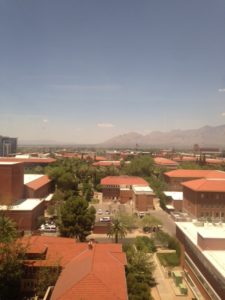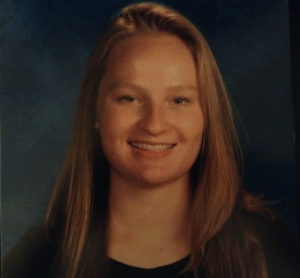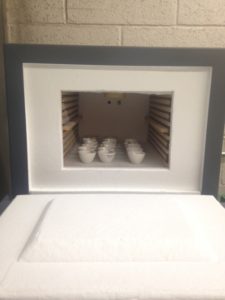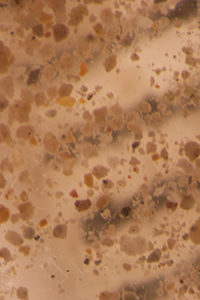My name is Cortney Cashner and I’m a student at Montezuma-Cortez High School.This summer I am interning in environmental science at the University of Arizona in Tucson through the Pinhead Internship program. My mentor is graduate student Nicollette Buckle, and we are working in the geology and environmental science building. Nicollette is in the process of researching Lake Ayauchi in Peru, she got to go there and obtain samples last summer. From the samples, the lake core, she will be able to assess the likelihood of a large-scale die-off event in the Amazon.

The Gould Simpson building is the tallest on campus. We usually come up here to enjoy the view while we eat lunch since there are no windows in the lab.
I drove to Tucson from Cortez last Friday and spent the weekend getting familiar with the area and the crazy, big city traffic. It really isn’t a problem though because I don’t need to drive through rush hour. My host family lives in Marana, Ariz. which is about 35-45 minutes away from the University. My host family parents are Steve and Chenoa and their three sons are Tanner, Caleb, and Dylan. Chenoa and my mom went to school together and have been friends ever since.
On my first day I needed to purchase a parking pass from the University so that I could park there legally. After that I went to the Gould Simpson building, about a block away, and met Nicollette. She gave me a quick tour of the floor and then we got straight to work.
I felt right at home in the lab because it reminded me of the lab back at my high school. We started by weighing empty crucibles, recording the weight, putting lake sediment in the crucibles, weighing them again, recording them, and putting them in the oven. I’ve done this every day and will continue to do this every day until I have data for every quarter inch of the lake core. This process is called Loss on Ignition and will help determine the organic matter content, carbonate content, and total carbon content.
At the same time I have also been analyzing the core for charcoal. To do this I use even more samples from the core and add sodium hexametaphosphate and bleach to break up the particles, making the charcoal easier to count. After the samples sit for a day we sieve them and take the remaining sediment to a microscope to count the charcoal particles. The charcoal analysis will illustrate past fire events and the characteristics of the fire.
I’m so grateful to Pinhead for this great opportunity! I’m loving every minute of it!




Awesome Cortney, we are so proud of you.
You’re a genius ! I’m proud of you to !
Awesome granddaughter awesome
Cortney how very interesting. Can’t wait for you to come home and tell us all about the results of your testing and work. What you’re doing matters. we are proud of your contribution to the project. Awesome girl awesome!!